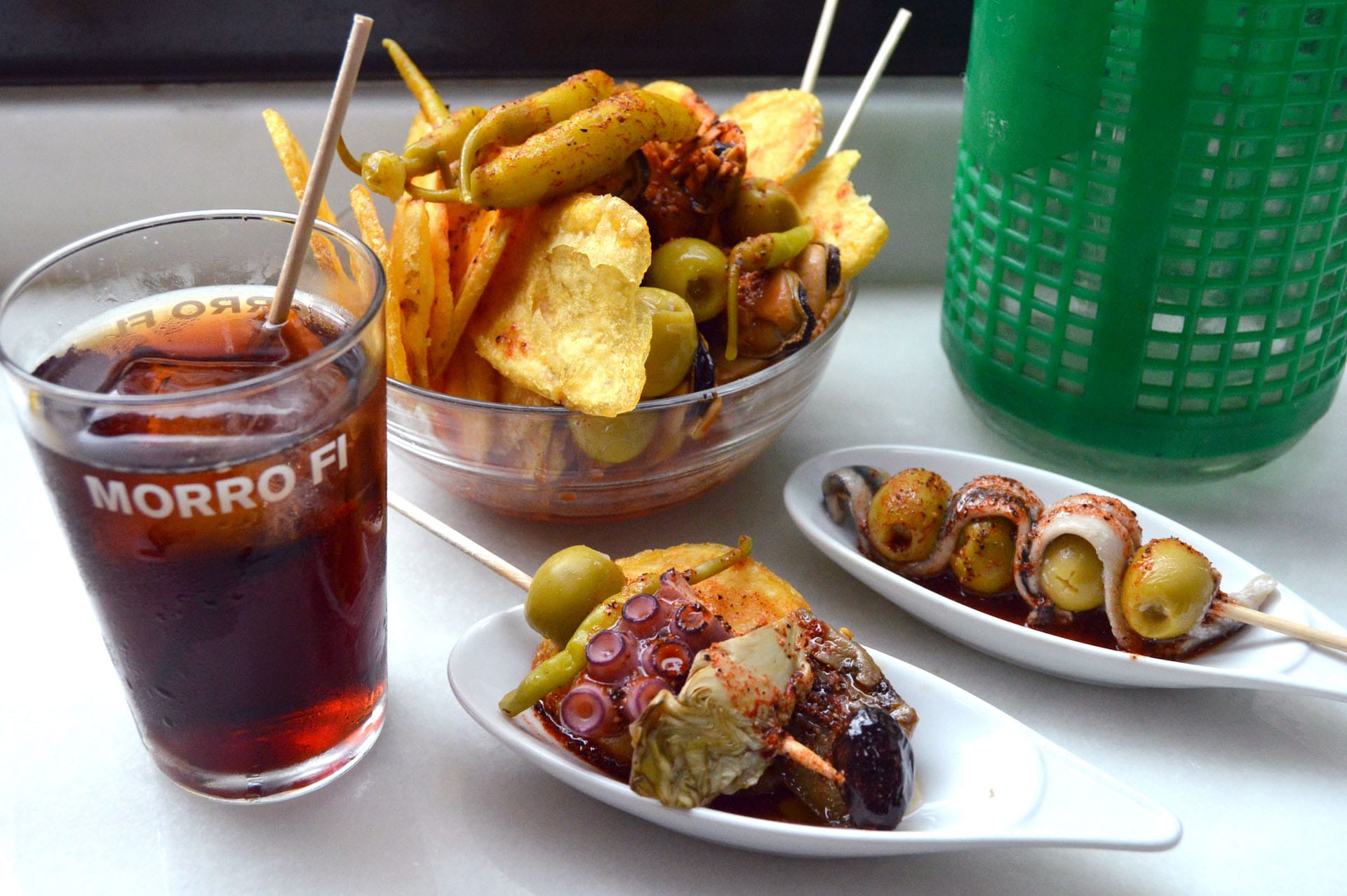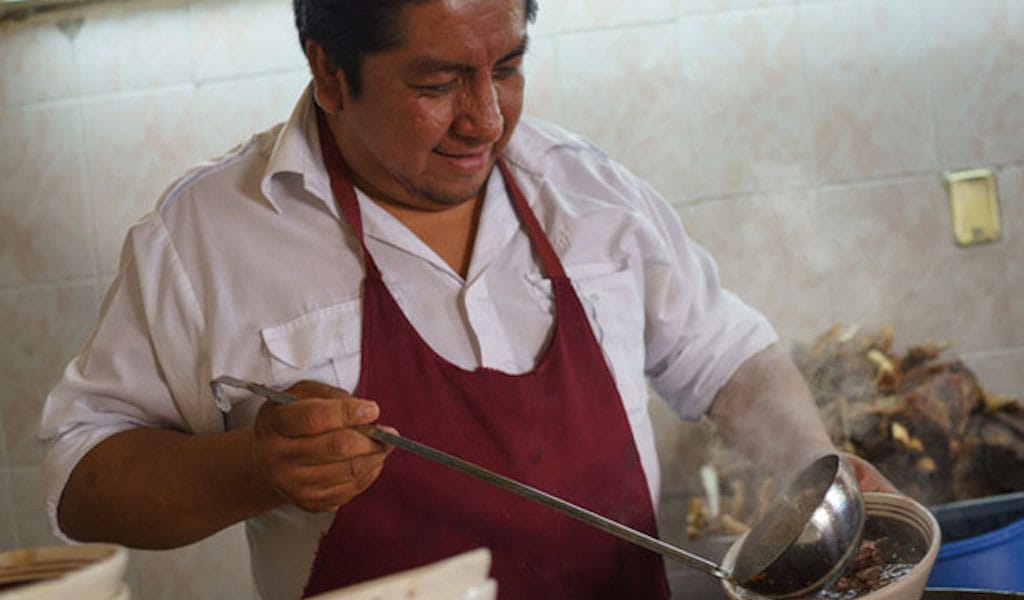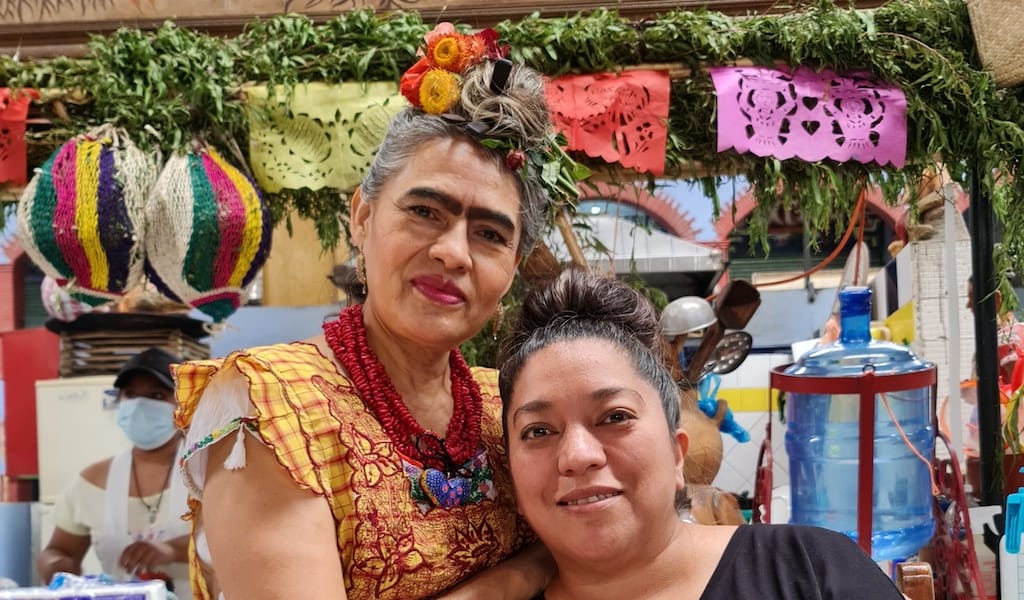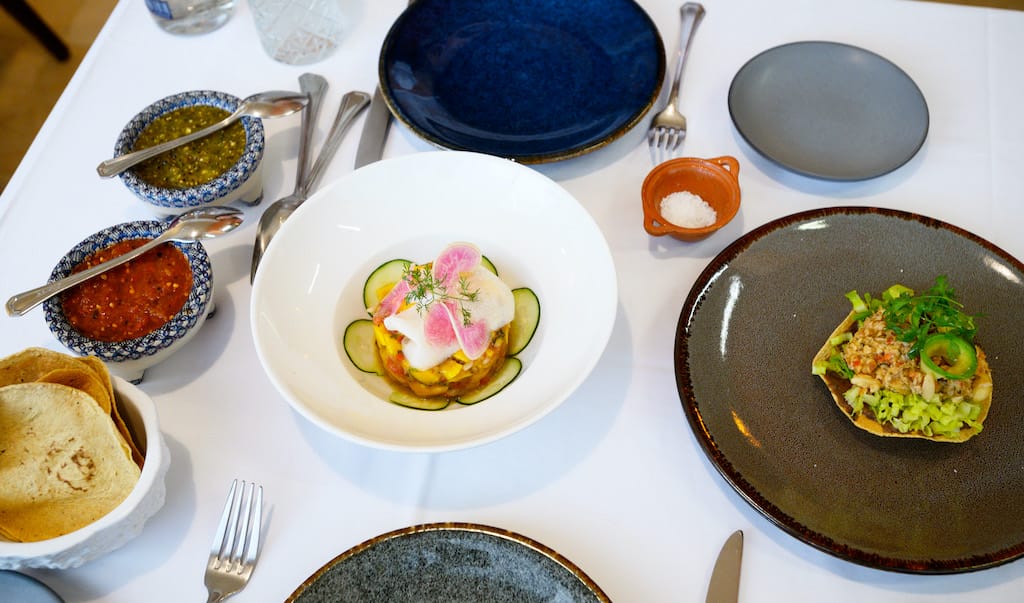The culinary scene in Barcelona has seen a slow and steady resurgence since the 1980s, when Spanish cuisine was still being reduced to paella and sangria in the popular imagination. With rampant growth in tourism, Michelin-stars being awarded to local kitchens left and right, and renewed interest in traditional wine-making techniques, Catalan cuisine in particular has become a force in its own right. So, where to find the best traditional Spanish and Catalan food in Barcelona’s many kitchens? Culinary Backstreets has you covered. Our local guides reveal the must-try dishes and drinks of the Catalan capital, and where to track them down, from tapas to top-quality vermouth at an old-school bodega to unforgettable seafood at a family-run marisquería.
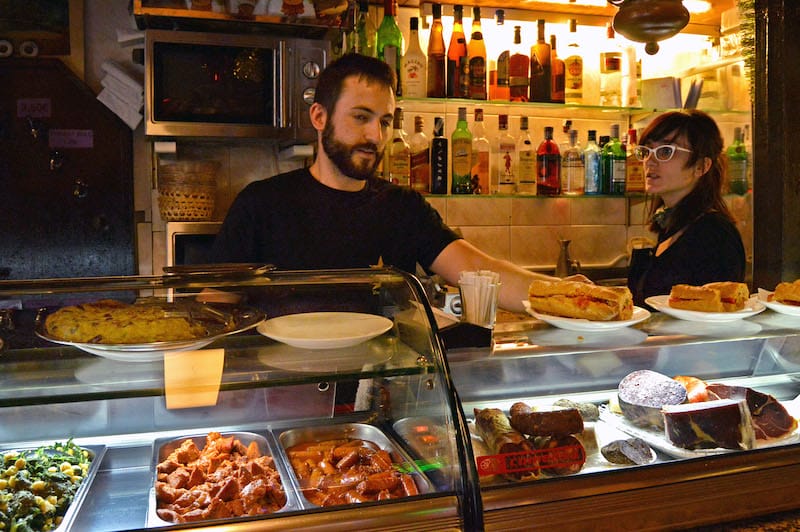
“Fork Breakfast” at Can Ros
Fried pig’s ears fortified with garlic and parsley, veal cheek and tongue laced with vinaigrette, hefty veal and pork meatballs, creamy artichoke or eggplant omelets, or a hearty bocadillo of marinated tuna, red pepper, anchovies and olives: these esmorzars de forquilla, or “fork breakfasts,” are how a Catalonian might start their day – especially at Can Ros, a tapas-and-bocadillos joint that’s open every day from 7 a.m.-midnight. Office workers drop by for a mid-morning coffee, the lunch crowd takes over from 2-4 p.m., and dinner, of course, lasts well into the night. It’s breakfast, however, that has made Can Ros most popular among locals.
Esteban Ros and his brothers opened the restaurant in 1971 with a selection of just five or six tapas. He has since retired, and five of his six children now run the place, offering around 50 hot and cold varieties of tapas. Brunch in Barcelona comes two ways: there’s the simpler, European-style version with fruit, coffee or tea and bread with an assortment of cheeses and marmalades. The more substantial traditional-style brunch, such as Can Ros offers, might involve a ham bocadillo, a tapa of callos (pig tripe and feet in a spicy sauce and chickpeas) or some butifarra, a Catalan sausage, with beans. Serious dishes like these deserve serious libations, which means wine, cava or beer – and coffee to chase it all at the end. It’s breakfast, after all.

Spanish Tortilla at Les Truites
Although it would seem that much of the world imagines the inhabitants of Spain subsisting largely on paella, the truth of the matter is that the tortilla de patatas really holds the place of honor in the hearts and stomachs of Spaniards. Often translated into English on menus as “potato omelet” (and called truita de patata in Catalan and tortilla española in some Spanish regions), this hearty round cake of potatoes and eggs has nothing to do with the traditional French omelet, nor does it have anything in common with a Mexican tortilla. The Spanish tortilla is of humble origins, and at its most basic is made by frying up a thick mass of sliced potatoes and eggs in olive oil and then slicing it into savory wedges.
For Barcelona, one neighborhood temple devoted to the omelet is Les Truites, a small family restaurant in Sant Gervasi run by Joan Antoni Miró and his son Marc. Since 1978, the Mirós have been morphing and re-morphing the original tortilla recipe, developing 180 variations on the dish and publishing two books about their findings. Made only with free-range eggs from Calaf (the best eggs in Catalonia come from this village), you can find a classic thick potato omelet with caramelized onion (succulent and creamy), and the popular butifarra (Catalan sausage) with bacon and potato (slightly spicy, rich and super tasty). Both omelets are available every day and are made to order, along with two other modern stars: the truffle tortilla with foie gras (aromatic and sophisticated) and a surprisingly iconic one made with a croissant and Jamón Ibérico. Back in the day, Les Truites’ clients were mostly their neighbors. But after almost half a century of lifting the art of tortillas to the cosmos, people journey from all parts of the city to enjoy the restaurant’s singular, eggy treats.

Croquettes at Pollería Fontana
For Barcelonians, croquetas (croquettes) arouse deep childhood feelings of nostalgia, like the memory of a crowd of fútbol fans celebrating after winning La Liga. Traditionally, croquettes are a homey, deep-fried dish made of leftovers – imagine a mozzarella stick densely stuffed with meat or veggies instead of stringy cheese. Readily found at tapas joints and bodegas all over the city, they are best when crunchy on the outside and creamy on the inside.
For chef Nil Ros at Pollería Fontana, instead of leftovers, a whole chicken goes into making the wonderfully elevated croquettes, with all the best parts perfectly roasted. No doubt the restaurant’s most-iconic tapa, the croquetas are addictive, full of that roasted chicken – and with a touch of Iberian ham. Though it’s everyone’s favorite, chicken isn’t the only option: octopus croquettes as well as mushroom and cheese options find themselves on the menu as well. All are as a croqueta should be, with a satisfying crunch and a rich interior.
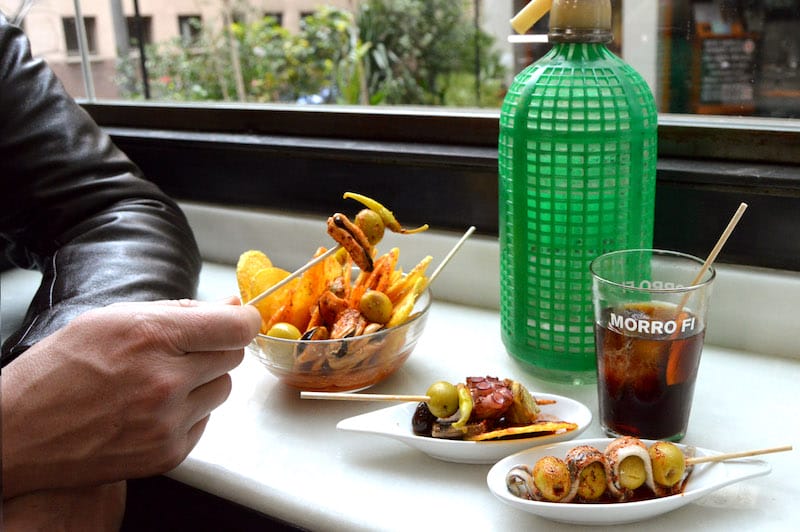
Vermouth Ritual at Morro Fi
Have you noticed the colorful, 1960s-era carbonated water siphons everywhere in Barcelona? They aren’t just retro decor – they’re the symbol of our beloved vermut ritual. The phrase hacer el vermut (literally “to do the vermouth”) in Spain has for decades described not only that delicious fortified wine, but also any kind of pre-lunch aperitif. Since the end of the 19th century in Barcelona, the vermut ritual – a fresh drink accompanied by tapas composed usually of preserved food, cold cuts, cured or marinated fish or seafood – has been a way to bring people together before meals. While the tradition languished a bit in recent decades, it never really disappeared, and since 2010 Barcelona has seen its revival through a mix of nostalgia and the modern taste for the finer things in life.
The Morro Fi project, with its four bars, represents the new generation of vermouth in Barcelona, bringing great quality and selection to all its products, drinks and tapas. Morro Fi, which in Catalan means “refined snout” or having a gourmet palate, was created by vermouth enthusiasts for those who like excellent eating (that’s all of us, right?). The partners behind the project have put out their own line of vermuts (red, red reserve and white), made in a fresh style, with real respect for the original ritual. Their growing success means these bottles can be found all across the city and at all kinds of events. The original venue, Morro Fi, has a younger namesake inside La Illa Diagonal shopping mall. We also recommend the other two locations in Gràcia/Sant Gervasi: Mitja Vida offers a bit more elbow room, and Dalt de Tot has a few tables on the street and a little kitchen that turns out more elaborate dishes, such as eggs, butifarras, omelets, croquettes and more.
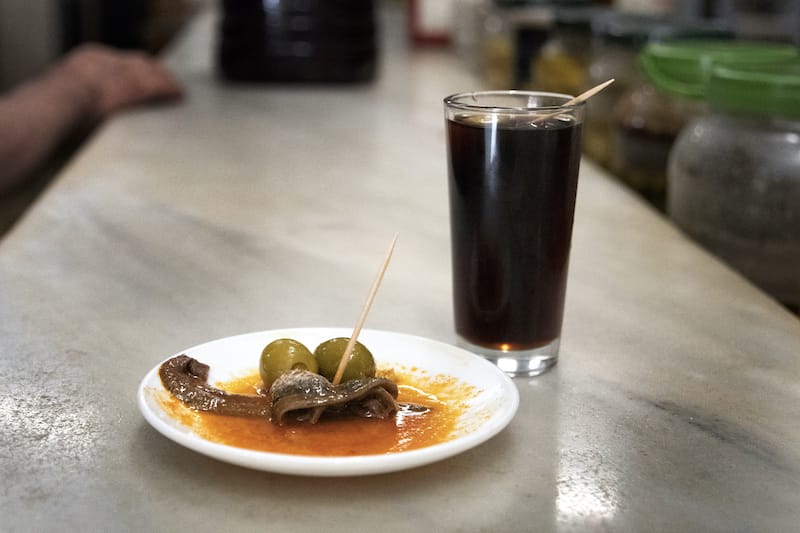
Bulk Wine and Drinks at Bodega Salvat
The easiest way to pick out a bodega in Barcelona is to look for big wooden wine barrels – they always, and we mean always, feature prominently in these taverns. Locals frequent their neighborhood bodega for myriad reasons: some come to buy affordable bulk wine from the barrels to take home, others to have a vermut with anchovies, or other drinks and tapas, for an aperitif. Sometimes, in those special cases where the bodega evolved to include a kitchen, they also come to enjoy a magnificent meal. These living monuments were, and still are, witnesses to Barcelona’s history, from the Spanish Civil War to the gentrification and intense “touristification” currently taking place in the city.
At Bodega Salvat in the Sants neighborhood, large wooden wine barrels perched on high shelves almost touch the ceiling, looking down on those drinking below with more than 100 years of local stories to tell. For several generations of Sants residents, this old bodega, opened in 1880 by the Salvat Vidal family as a bulk wine store, is a fixture of daily life. Bodega Salvat still maintains its old business of selling wine in bulk out of the few casks remaining in the main room. But these days it also serves as a vermuteria, with a great house vermouth, sold in bulk or served in the small and iconic oliveta glass – with one olive pierced by a toothpick. For beer lovers, Bodega Salvat offers five brews on tap, including its famous black beer, chilled in a steel keg that’s kept cold inside an old fridge from 1929. Also from 1929 are the iconic hand-painted tiles of the bodega’s main room. This more-than-100-year-old watering hole is now protected by the Barcelona City Council as an “iconic bodega.”
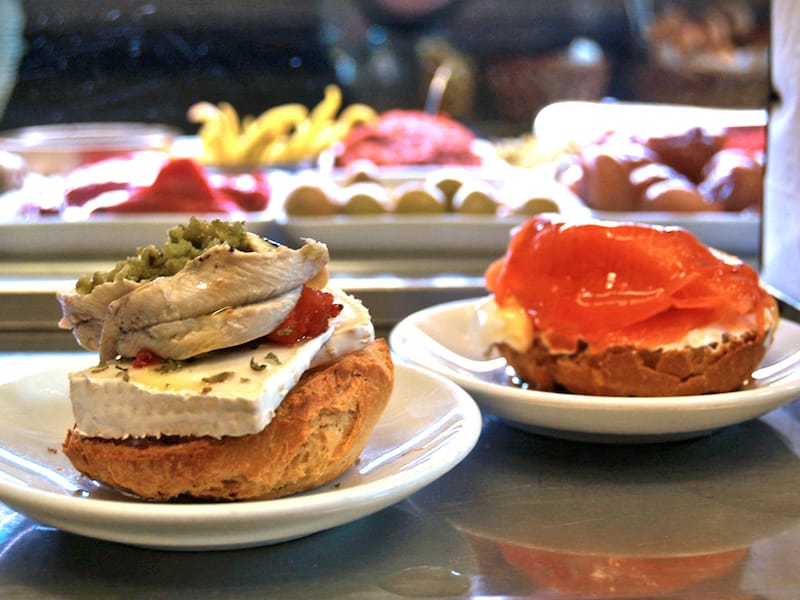
Conservas at Quimet & Quimet
In Spain, conservas, or foods preserved in cans and jars, are not simply a matter of economic survival or a source of basic nutrition for students, hikers, military recruits and the like. Rather, the tradition of conservas more resembles that of keeping one’s most beautiful jewelry locked safe in a strongbox – a prized possession to bring to the table on special occasions, and a unique snack that can be found in both traditional and modern bars and bodegas. From the earliest days at Quimet & Quimet wine shop – in the year 1914, to be exact – the proprietors would offer a dish of traditional conservas like anchovies to accompany wine. Over time, the very basic tapas were replaced by more sophisticated items, the anchovies joined by smoked sardines or sun-dried tomatoes.
Now known for its conservas, Quimet & Quimet displays them in their tins for sale on shelves behind the bar. As current owner Quim Pérez puts it, conservas are in the DNA of Catalonians and represent a culinary art that incorporates very high-quality natural ingredients and artisanal methods – an art that has nothing to do with the industrially preserved foods found in supermarkets. This artisanal process is given the star treatment in many of Quimet & Quimet’s nearly 80 tapas, montaditos and “combinations,” larger dishes that combine a variety of preserved meats, fish or vegetables. Which are the most special among the huge selection? There are the hard-to-find zamburiñas (a type of small scallops from Galicia), the pickled pheasant, or the Granada sturgeon, to name a few. Quim answers us, speaking about his food products as if they were his children: everything, everything is a treasure, he says.

Seafood at El Racó del Mariner
Step into one of Spain’s best marisquerías (seafood restaurants) and on the menu you will find a dazzling display of the ocean’s bounty: big meaty clams of different shapes and colors, cockles, scallops, oysters, goose barnacles, spider crabs and lobsters. All will have their own delectable consistency and texture and evocative flavors – from intense, sweet or floral to metallic or rich with umami. Like any Mediterranean city, this seafood tradition has long been a part of Barcelona’s cuisine, whether brought in from the untamed waters of Galicia, or fished from more local waters.
El Racó del Mariner is a family-run restaurant with strong ties to this heritage due its connection with the local fishing community. When the restaurant moved out from the old harbor to the Port Forum marina, it added a large terrace to complement its fantastic Mediterranean cuisine focused on fish and seafood – including some of the best seafood rice dishes in the city. Tasty and intense, the rice is rich with langoustines, Mediterranean red prawns, squid, mussels and clams. Every ingredient is well-defined in flavor. Then there’s the iconic grilled and fried fisherman’s tapas of prawns, langoustines, clams, razor clams, squid, octopus, sardines and anchovies. Perhaps the most classic dish is the morralla, or fried fish, but the most in demand are their great fish and seafood stews, soups, and seafood casseroles of lobster, hake or monkfish – and, of course, the exquisite rice dishes.
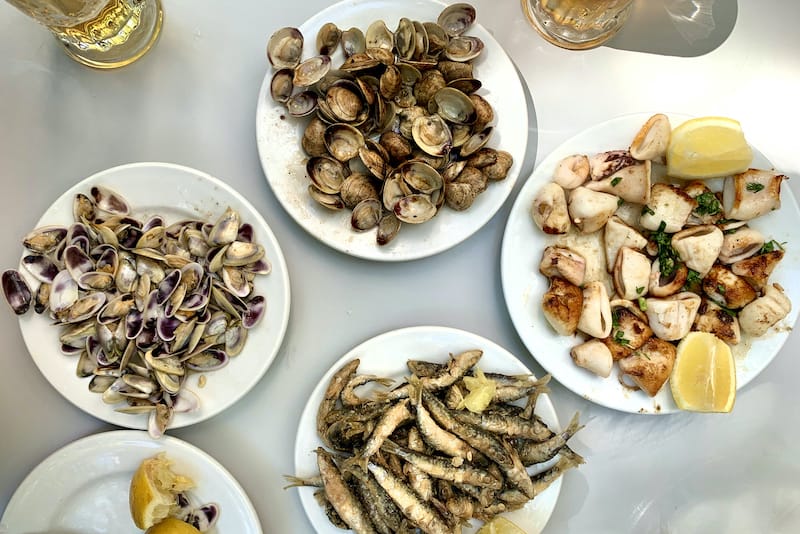
Tapas at La Esquinica
Perhaps the most-famous genre of Spanish food, tapas took the world by storm in the early 2000s. Tapas bars opened in big cities and sleepy suburbs all over Europe and the US, hoping to imitate the intimate and friendly ethos that goes hand in hand with these tiny shared bites. Tapas are somewhat amorphous in definition and vary greatly by region in Spain. But there’s no denying the charm of these little portions, especially when done right. Enter La Esquinica, an iconic tapas bar in Barcelona’s Nou Barris that serves excellent plates of seafood.
Here is the perfect spot: great tapas, good prices, personable waiters and a familiar neighborhood feeling. Cured, fried or grilled, the tapas are simply made and delicious. The menu is long, with more than 30 tapas plus some seasonal or daily specials ranging from oysters to green asparagus. And even with all the indoor and outdoor space, it’s still possible for lines to form on the weekends. Their specialties cover the spectrum of Spanish classics, from Galician-style octopus to Andalucian chipirones (fried baby squid) and Cantabrian anchovies. Of course, there are several Aragones specialties (as owner Jose María Utrillas hails from Aragon), like the celebrated Teruel cured ham, longaniza (chorizo) and morcilla (blood sausage). Some of our favorites are the more Mediterranean tapas, like chirlas or rosillonas (small saltwater clams). One final thing worth noting: they are famous in all of Barcelona for their patatas bravas.

Turrón from La Campana
Though its centuries-old history is murky, members of the Spanish aristocracy in the 1500s were crazy about turrón (a type of nougat), and its popularity eventually spread to all social classes and to other parts of Europe. Over time, this sweet with ancient culinary roots was further refined and, at Christmastime, it is not uncommon to see lines of people at Barcelona’s most popular maestros turroneros. They’ve come to snag some of the traditional, hard Alicante variety; the soft kind from the village of Jijona; turrón de yema tostada, Catalonia’s most typical nougat, made with egg yolk and a caramelized crust; contemporary adaptations made with chocolate truffle; and many other versions.
For those looking for a real local treat, we recommend La Campana (“The Bell”), a lovely little patisserie founded in 1850 by Francisco Mira Miralles, who came to Barcelona from Jijona village. La Campana uses top-quality products for their turrones, including Marcona almonds and a delicious rosemary honey (a type of monofloral honey produced in Spain). But, more than just the ingredients, what sets apart the nougat sold here are the intense flavors and textures, whether from the extra-crunchy caramelized sugar in the egg yolk nougat or the exceptionally smooth almond paste in the soft variety.
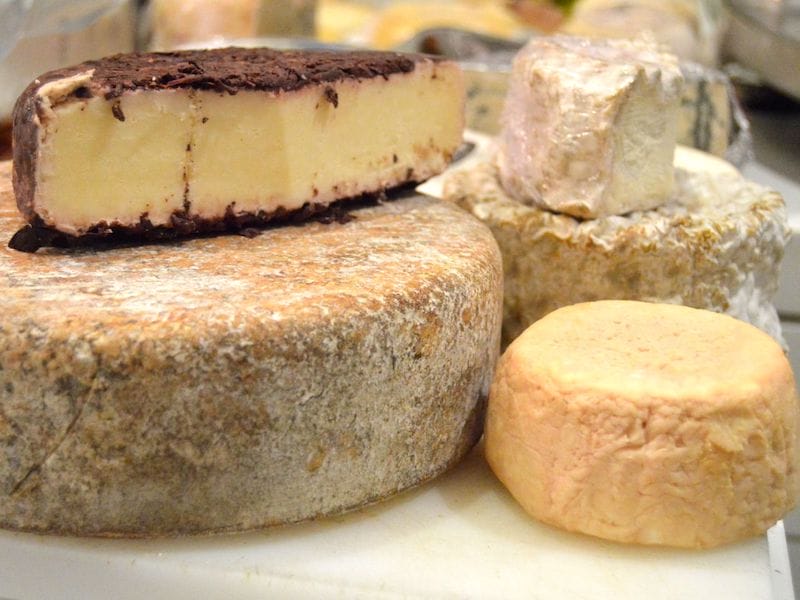
Catalan Cheese from Teca de la Vila Viniteca
Many gastronauts come to Barcelona in search of tapas or cutting-edge cooking, but rarely cheese. However, Catalonia, after all, produces the greatest variety of artisan cheeses of all the regions in Spain, with more than 150 kinds at last count, many of them made by small producers or in milk cooperatives in the mountains using both pasteurized and raw milk from cows, sheep or goats. While in the past, in order to taste these cheeses, one had to travel to the often-tiny village where a specific cheese was made, nowadays it’s much easier to find them at markets, restaurants, bars and specialized shops.
La Teca de Vila Viniteca is one such place, a highly regarded gourmet food and wine shop owned by the Vila family since 1932 – and equipped with its own cavas (caves) expressly for aging cheese. The oldest documented Catalan cheeses are mató, serrat and the singular tupí. Soft, spreadable, ricotta-like mató is very easy to make and is usually made from cow’s milk but occasionally also goat’s milk, and can be found at La Teca. There are, of course, Catalan cheeses of more recent origin, many of which have a protected designation of origin. Here, ancient recipes also mix with a new wave of cheeses that are being made. The shop works with artisan producers to create innovative, unique cheeses, which then mature in the cavas under the care of La Teca’s team.
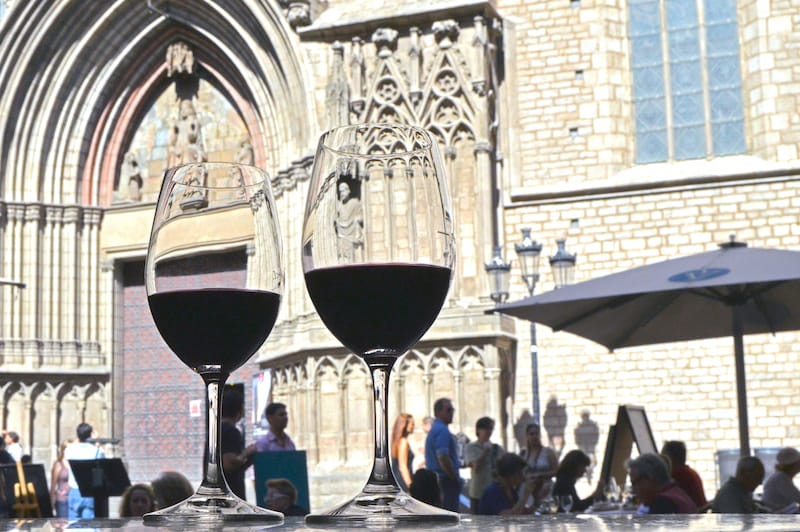
Catalan Wine at Vinya del Senyor
Catalonia has Spain’s greatest number of protected wine appellations, called denominaciones de origen or D.O. These 11 regions – not to be confused with the politically defined regions of the country – each have their own regulations designating grape varieties, soil types, weather conditions and production methods, and the four most significant among them, in terms of quantity, are Penedès, Costers del Segre, Priorat and Montsant. Although Catalonia is renowned for its cavas and white wines, some of Spain’s best reds are made here as well. All Catalan D.O.s produce good reds, but the most compelling and critically acclaimed wines come from Priorat, which is further distinguished by a Qualified D.O., or D.O.Q., and its younger brother, Montsant.
For a taste of Montsant or Priorat – not to mention the rest of Catalonia and beyond – we recommend two spots under the umbrella of Vila Viniteca. The company is a major wholesaler and distributor based in Barcelona run by Quim Vila, one of Catalonia’s most respected wine connoisseurs and educators. The Vila Viniteca shop offers hundreds of wines, most of them Spanish, as well as a full complement of gourmet food in front to pair with them. La Vinya del Senyor (“The Lord’s Vineyard”) is their charming little wine bar just a stone’s throw from the shop. It’s the perfect spot to share a bottle from the lengthy and impressive list or to sample by the glass from the selection of Spanish and international wines alongside a few choice bites. On a recent visit, the young and lively Comunica Samsó from Montsant played up a sweet, smoke-tinged dish of peppers and eggplants. The intense Priorat Les Cousins La Sagesse, made from carignan and grenache and aged 16 months in oak, was strong, structured and direct, boldly underlining the earthy flavors of cannelloni stuffed with chicken, pork and mushrooms. Finally, Álvaro Palacios’s elegant and enveloping Les Terraces subtly amplified the funk and complexity of secallona, a Catalan dry-cured sausage, but we would be happy to drink it all on its own.

Natural Wine at Contracorrent
Barcelona is natural wine’s flagship city in Spain, with an increasing number of specialized bars and restaurants joining the movement. Our most-recent favorite is Contracorrent (“Against the flow” in Catalan), a natural wine bar and restaurant that opened amidst a series of pandemic-induced openings and closings in November 2020. Catalan sommelier Anna Pla has a decade of experience in wine under her belt, including working at such Barcelona natural wine pioneers as Bar Brutal and Bar Salvatge. Her partner, the Sicilian chef Nicola Drago has worked in restaurants like the Michelin-starred Celler Can Roca. Their expertise is apparent on the well-crafted menu of sensational food (try the table-top smoked beef) and natural wine. Anna explains: “I have around 50-60 different wines on the menu, depending on the week, mostly natural wine from Catalan and Spanish small producers – we love to support local producers.” We do, too.
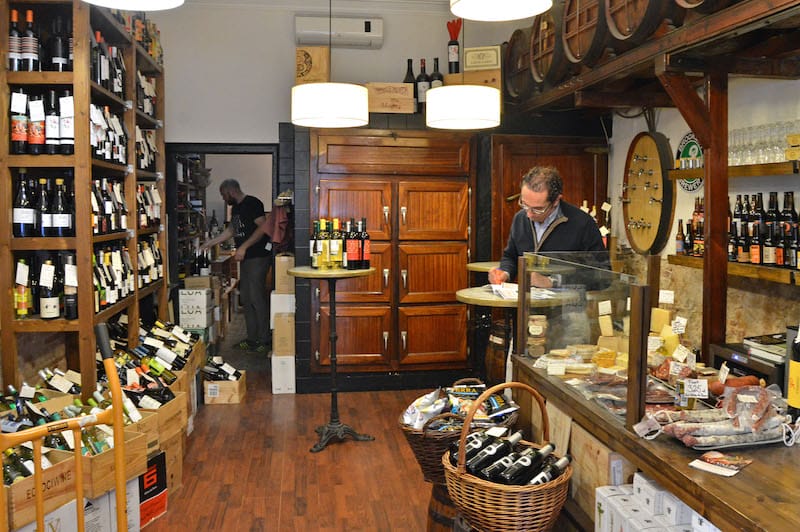
Cava at Bodega Bonavista
Cava, the Spanish sparkling wine, is an indispensable part of celebrations in Barcelona – though we’re happy to find other reasons to raise a glass of the stuff any day of the week (particularly on a dreary Monday). Produced using the same méthode traditionnelle for French champagne, the base wine is fermented from the pressing then bottled, usually with a mixture of sugar and yeast, to undergo a second fermentation to produce that festive fizz. While cava is produced in many areas of Spain, most production takes place in Catalonia, and especially Penedès, an area of historical importance for this type of wine. The word “cava,” in fact, means “cellar” or “cave” in Catalan. In the 18th century, Catalonians began learning about sparkling wine when they became the cork suppliers to the first French wineries that were making champagne.
In Gràcia, Bodega Bonavista is a young wine shop that is also a cozy delicatessen/tapas bar, with an impeccably curated selection of wines offered at fair prices. This bodega was a colmado, or traditional grocery, from 1938 to 2006. Today, Bonavista is owned by Marc Vidal, a Catalan wine merchant for more than 15 years, and his Norwegian partner, Christopher Grenness. They stock about 300 wines that change yearly, usually tasting around 20 bottles for each one that they decide to sell in the shop. Just ask Marc or Christopher for help selecting a cava, from sweet Dulce to a good Brut Nature. Keep in mind: typical white grape varieties of xarel-lo, parellada and macabeo are used to produce sparkling wines with fresh citrus flavors and bright notes of fruit and white flowers. At Bonavista, customers can sip their selections and nibble on wonderful cured sausages and cheeses at the few tables in the shop. Bonavista sells European craft and imported beers and other treasures as well.
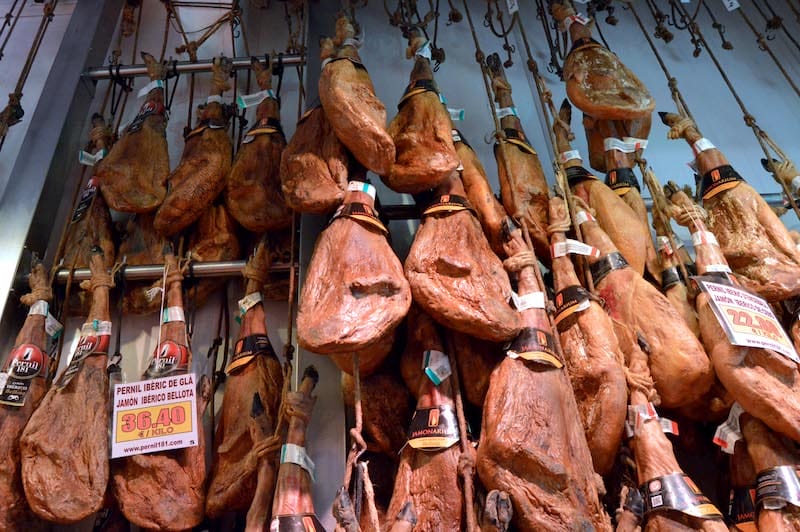
Iberian Ham at Jamonarium
In Spain, pork is serious business; it’s been a fundamental part of the diet here for millennia. Perhaps one of Spain’s best-known culinary treasures, different types of the cured meat offer specific flavors and characteristics, depending on the breed of pig, how the animal has been fed and raised and how its meat has been processed and cured. The two major categories of Spanish ham are jamón serrano and jamón ibérico. The former comes from white or pink pigs normally raised on farms and fattened on grain, while the latter comes from the Iberian breed and is made according to very specific practices, yielding a very special and often costly product.
At Jamonarium in Gràcia, hundreds of hams hang from the walls, top-notch jamón ibérico among them. The Iberian pig is an ancient breed of (usually) black pigs and probably originated from the cross of a pig brought to Spain by the Phoenicians (around the 9th century BCE) with the Mediterranean wild boar. They require much more time to reach maturity and the right weight for slaughter than conventional breeds. Spain’s best pork products – not just jamón ibérico de bellota (acorn fed), but also fresh cuts – come from pigs raised this way. The ham made from the black pig, pata negra (“black foot”), is easy to recognize at Jamonarium by the black hoof, the distinctive shape of the leg and the intense maroon color of the meat. Here, the jamón ibérico de bellota boasts a luxurious amount of fat, an incredibly silky, melting texture and uniquely sweet-salty flavors – as it should.

Roasted and Marcona Almonds at Casa Gispert
Abundant in Spain and commonly used for barbecues and grills, evergreen oak wood creates long-burning embers and has an excellent aroma – the smell of which evokes a range of childhood memories for locals. This nostalgia can also be concentrated in bites of food, particularly the almonds or hazelnuts that are roasted in a special wood-burning oven designed by the Romans. To find these smokey nuts, head to the oldest food shop in Barcelona, Casa Gispert.
The grocery was opened near the port in the Born neighborhood in 1851, serving as a retailer for all manner of “exotic” products and spices, including saffron, cinnamon and coffee, flowing into the port from faraway lands. They also sold local products like nuts and grains in bulk. Casa Gispert has both stayed stubbornly the same and slowly evolved, withs schools now organizing mini-visits to show kids the old scales and, of course, the timeworn oven. Sixty-five kilos of nuts can be roasted at a time, and the end result is a llargueta almond with a unique personality – the warm smokiness dresses the nut without overpowering its natural flavor. Also at Casa Gispert are excellent Iberian Marcona almonds. Plumper and more moist than your average almond, Marcona almonds are sweet and soft, with an almost buttery quality. While Casa Gispert now has an online shop, nothing beats a visit to this historic spot, where inevitably we find ourselves drawn to the old oven, whose flames we can taste in a tiny roasted almond.
 February 2, 2018 Birria El Güero
February 2, 2018 Birria El Güero
Colonia Santa Maria La Ribera, one of our favorite dining neighborhoods in Mexico City, […] Posted in Mexico City September 8, 2021 La Cocina de Frida
September 8, 2021 La Cocina de Frida
On my way out of Oaxaca center and on to the city of Santa Catarina Minas, a good friend […] Posted in Oaxaca June 8, 2022 Nicos
June 8, 2022 Nicos
It’s hot in Mexico City and Gerardo Vazquez, head chef of Nicos Restaurant, is thinking […] Posted in Mexico City
Published on May 24, 2024
Related stories
February 2, 2018
Mexico CityColonia Santa Maria La Ribera, one of our favorite dining neighborhoods in Mexico City, is home to the historic kiosco morisco. Built in 1884, the Moorish open-air pavilion represented Mexico at the St. Louis World’s Fair in 1902 and has been in its current location since 1910. Just a few steps west of it sits…
September 8, 2021
OaxacaOn my way out of Oaxaca center and on to the city of Santa Catarina Minas, a good friend suggested I make a pit stop to visit “Frida.” Me: “Wait! Frida? Frida Kahlo the Mexican art icon? But she died in 1954!” Him: “You'd better go and try her chile encuerado.” So here I am,…
June 8, 2022
Mexico CityIt’s hot in Mexico City and Gerardo Vazquez, head chef of Nicos Restaurant, is thinking about cooling off. “Spring in Mexico City is hot,” he says, “And for me, it is very connected to Lent…so, fresh foods, cool things, vegetable-focused dishes.” Tostadas are on the menu at Nicos today – crunchy baked tortillas, one with…







































